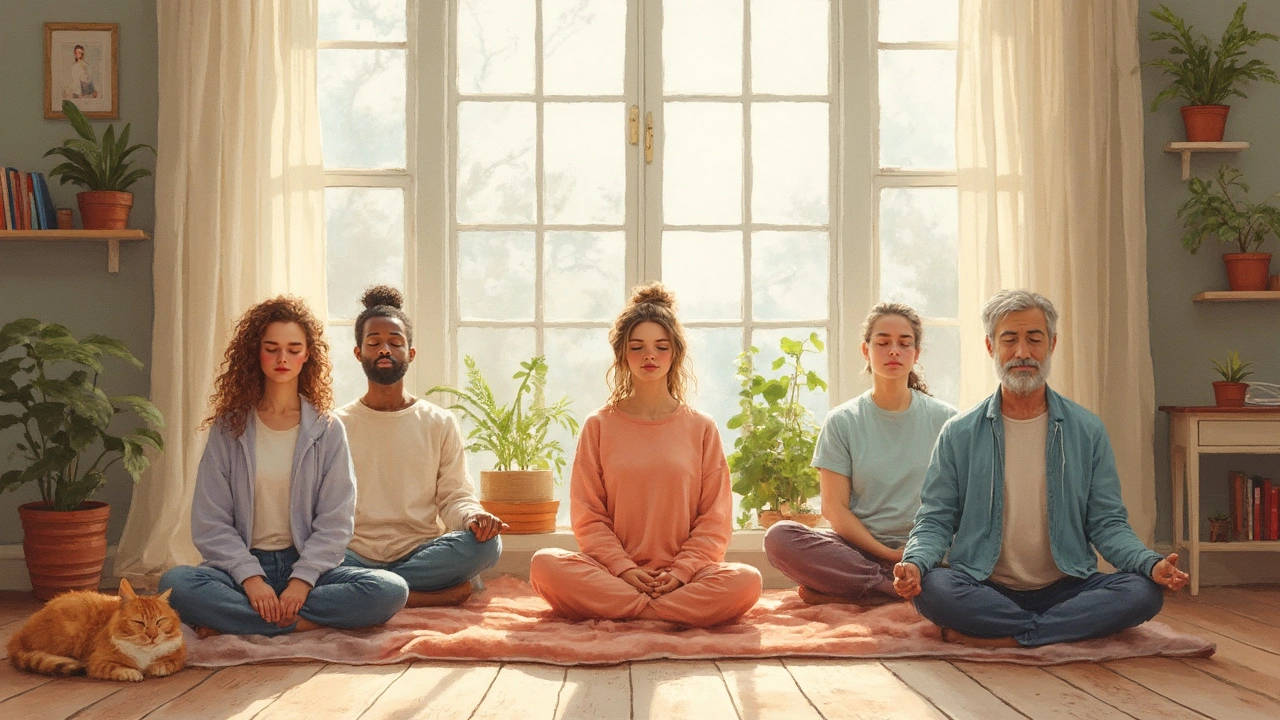Just imagine this: you wake up and your mind isn’t already racing. Notifications aren’t calling the shots. The stress doesn’t hit like a truck, and that annoying tightness in your chest? It’s just gone. This isn’t some fantasy that belongs in the “someday, maybe” category. Meditation isn’t a magic potion, but wow, it can rewire the way your brain handles chaos. Not just for monks, not just for crystal-wavers — the world’s top executives, athletes like LeBron James, and people who swore “my brain just won’t shut up” have all made meditation part of their toolkit. But how do you actually start, and how does it work? Let’s actually break it down, from the why, to the how, and even the weird roadblocks (like: what if you can’t stop thinking about pizza?).
How Meditation Works and Why It’s Worth Trying
Meditation is one of those words people throw around like “self-care” and “wellness,” but have you noticed how rarely someone actually explains what’s going on? Here’s the gist: at its core, meditation is about paying attention — on purpose — without judging what you notice. Sounds simple, right? But let’s be real, putting it into practice can feel like wrangling wild puppies in your head.
Most traditions fall into two main buckets: focused attention (think: following your breath or a mantra) or open monitoring (watching thoughts drift by like clouds). You don’t actually need to sit cross-legged or try to erase your brain. Instead, you gently train your focus, and when your attention wanders (because it will), you just notice — then bring it back. That’s it. And yes, this tiny act of returning your attention, again and again, literally strengthens your brain — fMRI scans out of Harvard have shown that even beginners can grow more gray matter in stress-related zones after just eight weeks of regular meditation. That means you’re not doomed by genetics or wired for panic forever.
Everyday life throws us curveballs constantly: deadlines, drama, the doomscrolling that hijacks what could’ve been downtime. Meditation gives your mind space — think of it like a mental muscle, building the strength not to get dragged into every little worry or insult. If you suffer from anxiety and insomnia, researchers at Johns Hopkins sifted through nearly 19,000 meditation studies and found convincing evidence that mindfulness meditation can be as effective as some meds for mild depression and anxiety, with way fewer side effects. Huge companies — from Apple to Google — have invested in meditation rooms and paid sessions for employees because the research stacks up: regular practice boosts focus, creativity, emotional resilience, and even immune function.
And let’s talk myths for a second. No, you don’t have to “empty your mind.” Humans have thoughts. The trick is learning how not to get caught up in their drama. Meditation is not about escaping reality — it teaches you to face it with both eyes open, less rattled, and more ready to handle whatever lands in your inbox. If you’re worried it’ll zap your ambition, actors like Hugh Jackman and CEOs like Marc Benioff are vocal about how it fuels, not dulls, their drive. Fun fact? The U.S. Marines have even added meditation training to help troops handle stress better in high-pressure environments. If tough guys in the military can see value in meditating, anyone can.

Different Meditation Techniques: Finding What Fits
Ready to dip your toes in? Here’s where it gets interesting — there’s zero need to wear saffron robes or chant om in a candlelit cave (unless you’re into that). Meditation techniques come in many flavors, and it’s easier than you think to match one to your personality or schedule.
- Mindfulness Meditation: This is the classic version. Sit, lie down, or stand (heck, you can do it on a bus seat), and pay attention to your breath. When your mind wanders, gently bring it back. Simple doesn’t mean easy — but it’s beginner-friendly and can be built into just three minutes of your day at first.
- Body Scan: Here, you move your attention through your body, from your toes to your scalp. Notice sensations as you go, without trying to change anything. Harvard med school teachers recommend this one for winding down before bed — it can calm racing thoughts and prep your body for sleep.
- Loving-Kindness (Metta): Wildly helpful if you’re your own worst critic. You silently wish well to yourself, then others (“May I be happy. May I be safe…”), expanding out to friends, strangers, and even people who stress you out. Regular practice has been shown to increase positive emotions and even block self-criticism, says a Stanford study from 2021.
- Focus Meditation: Pick a single thing to focus on — your breath, a candle flame, a sound like a bell, or a mantra (“Peace starts now”). When you notice you’ve drifted, just come back. This style is great if you crave structure — it can help tame the endless notification pings in your head.
- Movement Meditation: Prefer not to sit still? Walking meditation or gentle yoga can be powerful. The rules are similar: notice feet on the ground, rhythm of breathing, or the feeling of stretching muscles. It’s perfect for restless types or folks who process stress best through movement, according to research out of UCLA’s Mindful Awareness Research Center.
- Guided Meditation: Apps like Headspace, Calm, and Insight Timer offer instructions read aloud, which is a lifesaver when you can’t get your brain to stop buzzing enough to sit alone in silence. You just pop in headphones and follow along.
- Zen (Zazen) Meditation: This is old-school, often done in silence for longer periods. You sit still, breathe, and practice letting thoughts float by. It’s tough at first but can feel deeply grounding over time.
Here’s the deal: you don’t need to find the “perfect” meditation style today. Try one way for a week. If you hate it, switch. If you love it — awesome. You can even mix it up depending on your mood (body scan to chill out, guided meditation for stressful days). The best meditation for you is the one you’ll actually do. So, experiment. No one’s judging.

Tips to Build a Lasting Practice and FAQ
Sticking to a new habit is where most of us stumble. Maybe you tried meditating for a couple days, didn’t feel instantly enlightened, and figured you “weren’t doing it right.” Or you’re positive you’re “just too anxious” or “way too busy” to keep it up. Sound familiar? It’s normal. But there are some reliable tricks that can help you actually make meditation a real part of your daily routine, even if you struggle with keeping habits (I’m looking at everyone who’s ever let a gym membership go dusty!).
- Start small. Don’t go for 30 minutes straight out of the gate. Even one minute counts. Penn State researchers found people who started with under five minutes stuck with it twice as often as ambitious over-planners.
- Stick it to something you already do. Meditate right after brushing your teeth, when you start the coffee pot — piggybacking on an existing habit makes it way less forgettable.
- Don’t wait to feel like it. You probably won’t always want to meditate, and you don’t have to. Build a streak, not perfection.
- Track your progress. Use a journal, a habit app, or even tally marks on a sticky note. Watching your stats grow builds motivation.
- If you skip a day — let it go. Beating yourself up does nothing. Just start again the next day. Fun fact: Olympic athletes miss training days too; they don’t quit, they reset.
- Expect your mind to wander. That’s the point. Each “failure” to concentrate is actually a rep at the mental gym.
- Join others if you want a motivational bump. Many folks find meditating with a friend, a class, or over Zoom makes it feel a little less weird. Some companies and schools now offer free online groups.
Some other stuff folks always ask about: “Is it normal to get frustrated?” Absolutely. The struggle is real — and it’s totally human. “Can I meditate lying down?” For sure, just try not to fall asleep (though if you do, maybe that’s what your body needed). “Does the time of day matter?” Nope. Morning, during lunch, or at bedtime — they’re all fair game. The best time is when you’ll actually stick with it.
One sneaky tip: if you’ve got kids or a noisy house, there’s no shame in locking yourself in the bathroom for five minutes of “me time.” All that matters is you give yourself the space. And if your legs fall asleep, change positions! “Is it okay if I use music?” If it helps, go for it. Just keep it low and not too distracting, unless music is what’s keeping you from doomscrolling for that five-minute window.
Meditation isn’t about reaching some Zen superpower or levitating over your living room. It’s more about being less battered by your storms and more at home in your own brain. Most people notice subtle changes after a few weeks, not instantly. Maybe you won’t flip out at traffic. Maybe you’ll remember to actually taste your food. Maybe you just get a pocket of calm you didn’t have before. Whatever you get, it’s yours. No special equipment required. Just you, your breath, and the willingness to start over each day.







